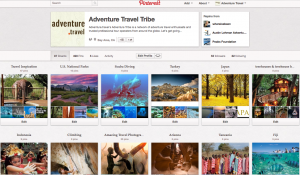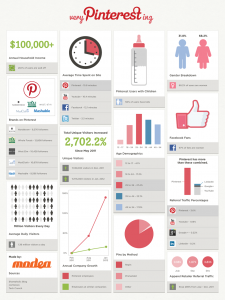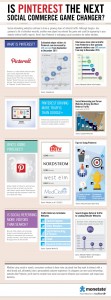![]() By Nicole Petrak, ATTA Special Projects & Assistant Editor to AdventureTravelNews
By Nicole Petrak, ATTA Special Projects & Assistant Editor to AdventureTravelNews
 You’ve likely heard of Pinterest by now — the two-year-old photo bookmarking site is being hailed as the hottest site of 2012 all over trade and mainstream media.
You’ve likely heard of Pinterest by now — the two-year-old photo bookmarking site is being hailed as the hottest site of 2012 all over trade and mainstream media.
Pinterest allows users to “pin” images and video content they like directly from the web or from other people’s Pinterest accounts and organize them via themed pinboards (note that Facebook currently does not allow people to pin photos from the site). People can create as many boards as they like, search others’ pinboards to find topics of interest to them, and “follow” any boards or pinners they want; there’s no option to create private pinboards but people can choose to allow or limit who comments on their boards.

The result: a cascading, online stream of visually-rich content that tends to spread like wildfire through active pinners — a demographic group that is skewed towards retail-conscious and relatively affluent women between 25 and 45 years old (see Infographic at right). (It’s interesting to note that Pinterest use in the United Kingdom, while just a fraction of the size of the U.S. user base, is quite different demographically. Pinners tend to be about a decade younger, much wealthier but with less formal education, and predominantly male —something to keep an eye on as the site grows in popularity.) The most commonly pinned content tends to be: clothing, crafts, design elements, home decor; food, beautiful outdoor and travel scenes; and inspiration/humor (often with quotes).
And there’s no denying the site is hot: the Silicon Valley Business Journal reported a few weeks ago that Pinterest grew by 52% to 17.8M unique users in February of 2012 alone, making it the the third fastest-growing website of that month (behind Healthline and IRS.gov).
Even more exciting is a Shareaholic study in January that found that the site’s total referral traffic (3.6%) in January beat Google+, YouTube and LinkedIn combined. In comparison, veteran Twitter is barely ahead of Pinterest, at 3.61%, and Facebook, which takes the lead at a whopping 26.4% referral traffic, ranks number two in traffic growth after Pinterest.
The most valuable aspect of Pinterest for brands is the site’s ability to drive web traffic. Social media and travel industry consultant Sophie Bujold explains, “On average, people who are using Pinterest for traffic generation are seeing about 5% of their total website traffic being directed from Pinterest, which is more than LinkedIn, YouTube and Google+ combined.”
Pinterest is a prime example of this evolution - it allows you to share visual content organized by topic (as broad or minute as you choose - think of boards geared towards “Travel” versus “Alaskan Tundra” or “Tropical Beach Camping”), and share other people’s content that you like.
Not sold yet? Notable pinners include Mark Zuckerberg, Yoko Ono, President Barack Obama. Clearly, the site is worth a look.
 Wherever the crowd goes, brands and marketers are quick to follow and adapt to for their best advantage; take heed, though, as the ‘culture’ of Pinterest (much like the early days of Facebook) is decidedly inspirational, personal and anti-commercial messaging. That’s not to say that people aren’t open to sourcing products to buy on Pinterest. In fact, the users regularly check out others’ content and follow links back to the original websites, and Pinterest has become a top traffic driver for retailers (see right).
Wherever the crowd goes, brands and marketers are quick to follow and adapt to for their best advantage; take heed, though, as the ‘culture’ of Pinterest (much like the early days of Facebook) is decidedly inspirational, personal and anti-commercial messaging. That’s not to say that people aren’t open to sourcing products to buy on Pinterest. In fact, the users regularly check out others’ content and follow links back to the original websites, and Pinterest has become a top traffic driver for retailers (see right).
However, the images that succeed (i.e., those that get re-pinned many times) are generally not slogans, ads, or commercials — they’re the type of images people might have previously dog eared or pulled from magazines for scrapbooks, “dreamboards,” and other sources of inspiration. A recent post from the American Express Open Forum by Mashable Associate Editor Lauren Drell names ‘Promoting a Lifestyle’ the number one way brands should be using Pinterest:
Pinterest designer and co-founder Evan Sharp sums it up well: “For most consumer brands, the idea behind your brand makes sense on Pinterest.” Since you’re not supposed to blast pictures of your products on Pinterest, try to think outside the box and pin images that capture a lifestyle and/or the essence of your brand. Pinterest calls for a more holistic approach to marketing, and it can be more effective and engaging than traditional advertising because the consumers can really see how your brand fits into their lives... Beyond pushing one’s products, you also can use Pinterest as a way to convey your company culture — post pictures of the office, the mascot, people’s cubicles, lunch breaks and office events. Fans are interested in these details, and this imagery helps to humanize the brand.
The post cites the Travel Channel as a good example:
With access to destinations far and wide, the brand is able to fill up boards of beaches, food, city landmarks, exotic animals, travel souvenirs and more. There are even boards devoted to the channel’s various shows to give an inside look at what goes on when the camera turns off and to offer insights into the hosts’ travels.
Obviously, the travel industry is ripe with beautiful and exciting photo and video content, and travel is a highly aspirational product for which consumers often spend a prolonged amount of time dreaming and researching before purchasing. But before exploring the multiple ways adventure travel companies can capitalize on the new site, we must acknowledge a few downsides:
Remember that while Pinterest might be experiencing intense growth that it remains far behind social networking leaders Facebook, Twitter and LinkedIn for total unique visitors; analyze your target market and your marketing resources carefully before spending lots of time or money here.
The site has raised serious questions around copyright issues
When you share an image from any given source, you can edit or erase the caption or commentary of the last person who shared it, allowing for pinners to edit down to their most personal reactions on the content they’re sharing. So if you, the brand, shares a photo that is captioned “A giraffe in Kenya spotted on NatGeo’s #1 Safari for 2012, by Really Cool Travel Company,” the next person who pins it might delete that comment and write “Awesome, I love giraffes!” The question is how much useful reach can you get out of purposefully sharing these images?
Ready to jump into Pinterest? Don’t forget some basics to getting started:
Use your logo as your profile picture — help people identify you
Utilize the ‘About Me’ section — give a brief but interesting description of your brand and products, convey personality, and link to your website, blog, Facebook and other properties
Pin high quality, visually stimulating images — that is, after all, the point!
When pinning, be descriptive in the comment area — this will help people find you via keyword searches
Give proper attribution to images that are not yours
Consider investing in overlaying your web address or company name on images that are likely to go viral
Elicit interaction: advertise your Pinterest across your other sites once it has some good material on it; interact in the Pinterest community; leave some of your boards open so others can contribute photos to them and invite them to do so.
Stay on top of innovations in how brands are using Pinterest — the site has its own pinboard library dedicated to this, including sections on Pinterest contests, legality issues, business case studies and more.
Other resources for more info:
How to Track Your Website’s Content on PinterestHow to Track Traffic From Pinterest in Google Analytics
What Pinterest Means for Hotels
Brands on Pinterest (pinboard)
250+ Brands on Pinterest
